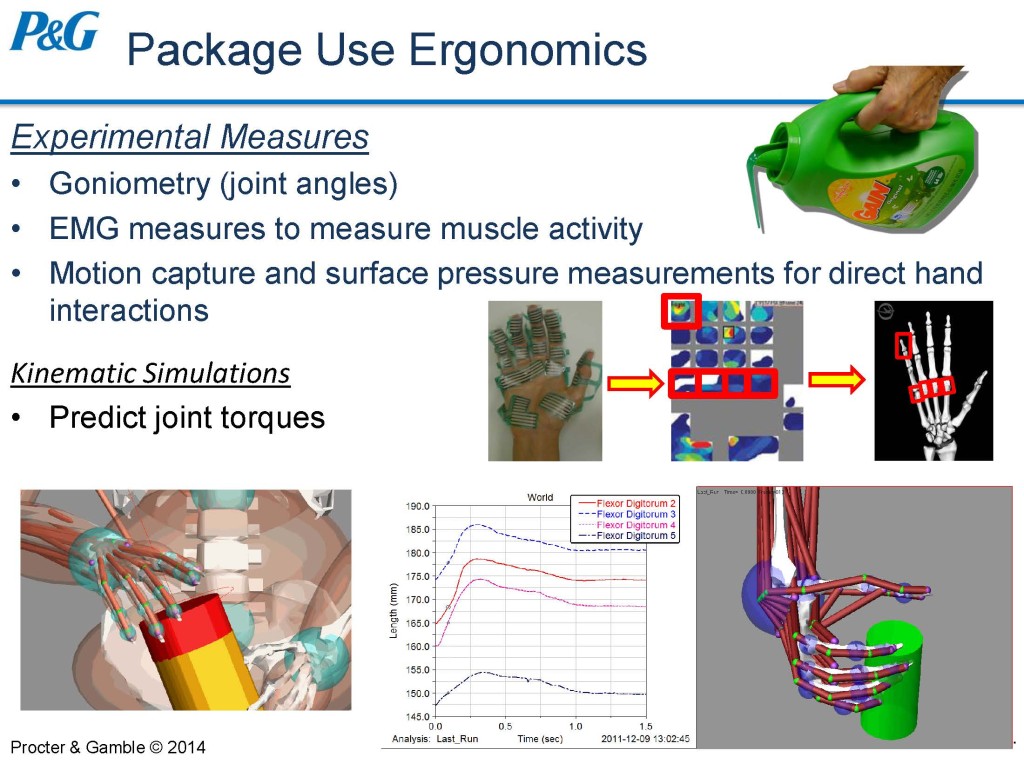Have you ever dropped your brand new razor or a full bottle of hand soap on a tiled bathroom floor and wondered why it didn’t simply shatter into a dozen pieces or split apart and create a gooey mess? Maybe next time that happens, you’ll thank computer modeling and simulations, not just your lucky stars.
 “What most people don’t know, is behind each one of those everyday mishaps, as well as the routine use of all those household products that help get us through each day, is an amazing amount of science, engineering, and high-performance computing,” said Tom Lange, Director of R&D, Modeling & Simulation for the Procter & Gamble Company (P&G), who addressed attendees at XSEDE14, this year’s conference of the National Science Foundation’s (NSF) Extreme Science and Engineering Discovery Environment (XSEDE) program in Atlanta this month.
“What most people don’t know, is behind each one of those everyday mishaps, as well as the routine use of all those household products that help get us through each day, is an amazing amount of science, engineering, and high-performance computing,” said Tom Lange, Director of R&D, Modeling & Simulation for the Procter & Gamble Company (P&G), who addressed attendees at XSEDE14, this year’s conference of the National Science Foundation’s (NSF) Extreme Science and Engineering Discovery Environment (XSEDE) program in Atlanta this month.
Lange’s responsibilities at P&G – founded 177 years ago and now doing almost $85 billion annually in global sales – spans consumer modeling; computational chemistry and biology; computer-aided engineering in structures, fluids, chemicals and controls; and production system throughput and reliability. From studying the micelles, or an aggregate of molecules in a solution such as detergents, to modeling the stratum corneum to better understand the physical properties of skin, Lange has spent his 36-year career modeling and simulating product formulations as well as their packaging. He and his colleagues have even optimized how these products are mass-produced – often to the tune of one billion items in just a matter of days – enabling P&G to achieve volumes that dwarf those of automobiles or even now-ubiquitous electronic devices such as laptops and mobile phones.
Lange has studied aspects of these household products that most of us simply take for granted: exactly how household cleaners must remove stains while protecting the fabric as well as one’s skin, how the varied sizes of infants directly correlate to fit from a diaper – and its urine leakage risk. He and his team at P&G have been using various XSEDE resources and expertise, such as those at the Ohio Supercomputer Center and the National Center for Supercomputing Applications (NCSA), in addition to other resources including the Department of Energy’s national labs at Los Alamos, Oak Ridge, and Sandia to help solve a wide range of challenges, primarily by jointly developing detailed simulations that predict performance, durability, and other metrics long before these consumer products hit the store shelves.
“High-performance computing is the theme that made all of this possible,” Lange told XSEDE14 attendees, noting that while advances during the last decade alone have enabled much more accurate simulations demanded by what he calls “the relentless pursuit of realism.” As a society, he noted, we have been on this learning curve for at least the last 60 years or more.
“I like to say that computing and modeling and simulation have changed science and engineering the way aviation changed travel,” Lange said, noting that at some point predictive modeling became an integral part of engineering and analysis replacing the crash-testing expensive prototypes – be it an aircraft or a new line of aerosol cans –demonstrations that bore no resemblance to the final production versions in the first place.
“I’m in the business of shaping decisions,” Lange said. “I make money with modeling and simulations, by either doing something, or not doing something that we would have done by experiment. I would much rather do stuff that tells you those things before they happen, not after.”
Contradictions and Scale
From an engineering perspective, many consumers may still think that everyday consumable goods such as detergents or diapers are ‘low tech’, when in fact the challenges faced by scientists and engineers working on P&G’s extensive product portfolio are in principle similar to those in rocket science. “High tech is not just for rockets, airplanes, cars, drugs, or smart phones” said Lange.

In describing P&G’s product development challenges as ‘contradictions and scale’, Lange explained that often, even the most common household product must have characteristics that are scientifically opposed to each other to work as flawlessly and effectively as possible. That’s where HPC resources and expertise come in, by making it possible to model many thousands of iterations of a single product characteristic with less time and less cost, but with consistent results – and no unpleasant surprises for consumers.
“Paper towels must be absorbent, but be very strong when wet,” he said. “Diapers need to be absorbent, but not leak and fit and comfort babies like cloth. Laundry treatments need to remove stains but protect fabrics, yet be concentrated and still be easy to use. Containers should never leak, but open easily. When dropped, they shouldn’t break, but they should use a bare minimum of plastic that also recycles well. Most importantly, all these products must represent a good value for improving daily life, not just affordable for use once in a while.”
As for scale, using computational science to improve products is also done to meet the demands of high-volume production. Taken together, contradiction and scale require a systematic process: first, a business challenge must be translated into a science challenge and expressed in science equations. Then all relevant data must be collected, such as material properties, production capabilities, even consumer ratings. Then simulations must be conducted and then effectively communicated at a non-expert level before final decisions are made and actual output begins.
Such computational modeling is used across the entire product spectrum and involves computer-aided engineering (CAE) skills in just about every area. For example, kinetic simulations are done to measure muscle activity and joint angles of the arm and hand when a person lifts a full jug of laundry detergent and twists off the measuring cap time after time. Others focus on how to produce billions of diapers each year that are absorbent, comfortable, and leak-proof. Many of these simulations require cross-disciplinary CAE skills.
“Here’s one – free surface flow on and through a compressible, partially saturated porous media with non-Newtonian behavior. That’s a kid going potty in his diaper,” said Lange.
Looking Ahead
A key challenge for companies such as P&G will be to ensure that computational analysis is eventually democratized, Lange told XSEDE participants. “High-performance computing and modeling and simulation skills need to be a base for all scientists and engineers. We need to be replacing the hand calculations of our education – most of them but not all of them – with computation and calculation.”
Another challenge will be for companies to develop an archive of its many thousands of simulations, and to be able to have the capability to reproduce an analysis done maybe five years ago by another researcher, said Lange. “We need a ‘library science’ to emerge for how we record and manage our simulations.”



























































